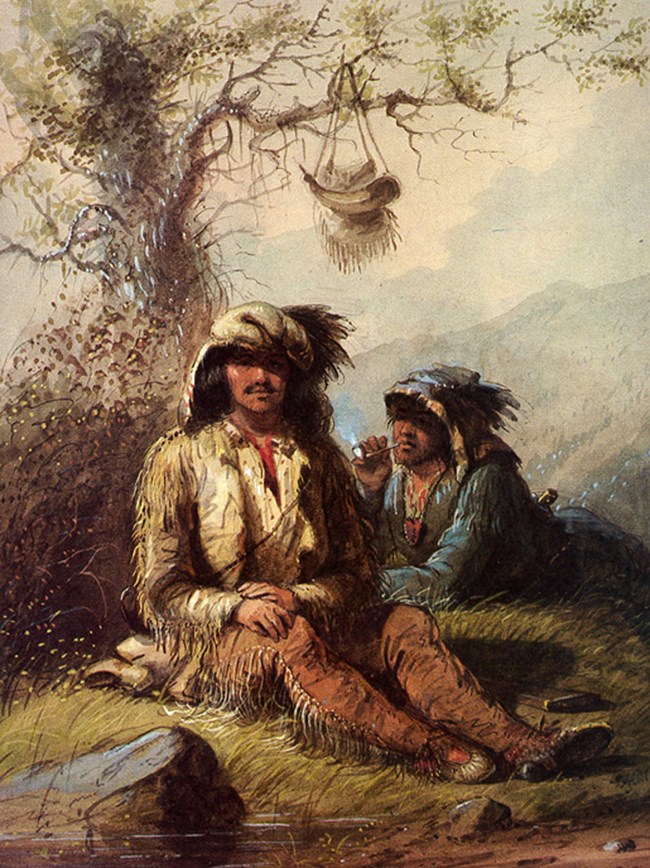
NPS
Angelica Sanchez-Clark and Michael Taylor El Camino Real de los Tejas Community Engagement Project, Laredo, TX, April 2015
Accompanied by Steven Gonzales, executive director of El Camino Real de los Tejas NHT Association (ELTEA), Angelica and Mike spent four days in the Laredo, Texas, area, conducting site visits to (1) Paso de Indios located on the Laredo Community College Campus, Los Corralitos, La Union, and San Ygnacio, (2) Laguna Espantosa in Dimmit County, near Carrizo Springs, and (3) sites in San Antonio.
As a result of the site visits, several opportunities for preservation, signage initiatives, and partnership activities have been identified.
In Laredo, a community outreach event, "El Camino Real de los Tejas in Northern Mexico and South Texas," was held at the Border Heritage Museum. The event was well attended by Laredo community members and by several delegates from the Instituto Nacional de Antropología e Historia (INAH) centers in Nuevo León, Coahuila, and Tamaulipas, Mexico, as well as from the Colegio de la Frontera Norte in Nuevo Laredo.
NTIR and ELTEA will be focusing on future partnership efforts in South Texas, including an upcoming dual workshop for El Camino Real de los Tejas and El Camino Real de Tierra Adentro national historic trails tentatively scheduled to take place June 2016 in Laredo.

Courtesy Colorado Springs Pioneers Museum
Mike Olsen That Broad and Beckoning Highway: The Santa Fe Trail and the Rush for Gold in California and Colorado (narrative book, August 2013)
Unlike the Oregon Trail, the California Trail, and other emigrant trails, the Santa Fe Trail is known as a commercial thoroughfare. When it opened in 1821-22, teamsters began hauling a dizzying variety of goods—and passengers—eastward from Santa Fe (capital of New Mexico province in the newly independent nation of Mexico) and westward from Franklin (a river town in the new state of Missouri). That two-way trade characterized the Santa Fe Trail throughout its 59-year history. Repeated generations of historians repeated these shibboleths—both before 1987, when the trail was designated a national historic trail, and in the years since.
In 2012, however, respected Colorado historian Michael Olsen approached National Trails Intermountain Region (NTIR) with the near-heretical notion that for two short, tempestuous periods, the Santa Fe Trail behaved much like its emigrant trail counterparts.
About a year later, Olsen completed That Broad and Beckoning Highway: The Santa Fe Trail and the Rush for Gold in California and Colorado. Olsen's volume noted that during both the 1849-1851 period (of the California Gold Rush) and the 1859-60 period (of the Colorado Pikes Peak Gold Rush), gold seekers used the Santa Fe Trail, in combination with other routes, to reach the end of the trail and to start mining.
While the Santa Fe Trail was not the principal way in which westbound travelers reached these gold districts, Olsen's research emphasized a brief period that no previous historian had described to any significant degree. As a result, many previously unknown opportunities now exist along the Santa Fe Trail to interpret the Gold Rush aspect of national historic trails to the traveling public.
www.nps.gov/safe/learn/historyculture/trailwide.htm (see Santa Fe Gold Rush Study)

Library of Congress, painting by Alfred Jacob Miller
Shirley Ann Wilson Moore, Sweet Freedom's Plains: African Americans on the Overland Trails, 1841-1869 (narrative book, January 2012)
Dr. Moore, a history professor at California State University, Sacramento, worked with the NPS to create this groundbreaking study about the African American emigrant experience on the Oregon, California, and Mormon Pioneer national historic trails. Her engaging study on this little known component of American history can be found in the History and Culture portion of the California National Historic Trail website.
Moore's study includes the following excerpts:
"African American men, women, and children were western pioneers too. Enslaved or free, they were an integral part of the human tide that undertook the long journey across the continent." "Black people, like their white counterparts, crossed the plains for myriad personal, economic, social, and political reasons. The lure of free land, new business opportunities, and individual autonomy were aspirations shared by both groups."
"Clearly, the lives, hopes, and expectations of nineteenth century black people differed in critical ways from those of white people. As a result, African Americans understood and experienced the westering journey in ways that white emigrants could not. The study of the African American experience on the trails broadens our understanding of the nature, scope, and meaning of westward migration. The experiences of the thousands of black men and women who came west compel us to reconsider the traditional narrative of our nation's history."
www.nps.gov/oreg/learn/historyculture
Photos on pp. 216-266 of the study.
Last updated: April 23, 2025
